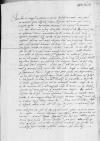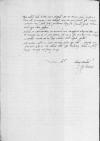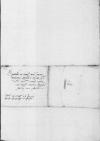Non possum me continere, quin aliquid scribam, praesertim tali amico, qui novit compati egenti. Quod scripsi, mercatores hic avisatos de provisione mea, hoc illud erat in fieri, non in facto. Thezaurarius iste ille written over hic⌈hicilleille written over hic⌉ purus Iudaeus ac usurarius Barensis promittebat de die in diem ⌊Io(anni) Violae⌋ ⌊Bari⌋ deponere provisionem meam et ille iam hic avisaverat suos socios, quod mihi praestare possent CCC-tos ducatos ob spem illius meae provisionis. Tandem nescio, quas cautelas Hebraeicas ille bonus vir exigebat ab eo, quibus eum ligare voluit. Et hactenus technis laboravit, et nec illos 300, immo nec istos 200, quos ⌊Bononiae⌋ accepistis, solvere curat. Habeat laudem ⌊hera nostra⌋ de his tam oboedientissimis officialibus et publicanis. Prope est, quod nec illi quidpiam dabunt, quandoquidem per tot annos nil penitus dederunt, neque illam curabunt, quae quantumcumque illis indignata fuerit. Et quis illorum erit, qui alterum castigabit(?). Scripsi ego ⌊serenissimae maiestati suae⌋ huc sub dat(o) 13 Maii per mercatores Cracovienses unacum illis litteris Vestris, scripsi et ultima eiusdem per appotecarium Plocensem, scripsi et nuper XIX huius per Alexandrum, qui per ⌊Isbruk⌋ cum canibus abiit, parvam, immo nullam, spem nos habere in thezaurario, si aliter sua maiestas de nobis non providebit. Et si illa non curabit, curabunt fratres mei, sed hoc meminisse iuvabit. Rogo Magnificentiam Vestram, si ibi venerint litterae ⌊serenissimae maiestatis reginalis⌋ aut de ⌊Bario⌋ vel de ⌊Neapoli⌋, apperiat eas, et si quid erit de provisione mea, consulat cum ⌊dominis Welseris⌋, ut mihi hic ⌊Venetiis⌋ respondeatur. Tamdiu hic manebo, donec habebo, si non a ⌊regina⌋, saltem ab amiciis. Et tunc utcumque veniam ad vos omnino et per illam viam ibo. Interea tentabit adhuc aliquid de defensis ⌊Montis Serici⌋, sicut(?) ante iam bis scripsi et informationem misi.
Nova nulla sunt hic praeter id, quod suspicantur omnes pestem et multae domus sunt infectae. Nuntius ⌊Thurcarum⌋ iam abiit bene honoratus ac donatus. Nuntius ⌊caesaris⌋ Hispanus, qui hic est, retulit pro certo nuntio ⌊regis Franciae⌋ Lazaro Balisto or Balisio⌈BalistoBalisto or Balisio⌉ XV huius relaxatos esse filios ⌊regis sui⌋, sed nondum in ⌊Franciam⌋ traductos. Iste promittit hic mirabiles facere triumphos, quam primum aud<i>verit esse traductos.
Ego nullas litteras habui nec e ⌊Neapoli⌋ nec e ⌊Bario⌋, quomodo successerit cum illis excompritis pro adohis, nec scio, qui faciunt istae umbrae. Valeant iam, nolo plus practicare cum eis. Faciant, quid velint, dummodo ego abire possem.
Saluto ⌊dominum Bernardum⌋ et ⌊Drevicium⌋ meum et afferam aliquid illis mecum e ⌊Venetciis⌋, et Dominationi Vestrae, quae potero. Frater meus est ⌊Padvae⌋ cum Dluski in studio, veniam ad vos cum omnibus, sed nescio, quando.
Nil solvat Magnificentia Vestra huic portitori, solvi ego illum. Commendo me plurimum Magnificentiae Vestrae, et utinam illam cito videam sanam et felicissimam.



 UUB, H. 154, f. 24v
UUB, H. 154, f. 24v